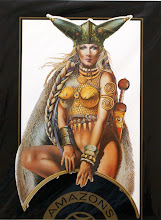Born in Lviv (now part of the Ukraine) on 29 January 1900, the son of physicia Vladimir Pajączkowski, who was the director of the General Hospital in Sanok for many years, and his wife Wanda Sękowskich Pajączkowska. Stefan Pajączkowski graduated from the Gimnazjum Sanockim in 1918 and then aided soldiers returning from the front, earning a silver medal from the Austrian Red Cross. It was during the war, and a visit to Vienna's museums and galleries, that his passion for art grew, although at the end of the war — and with it the collapse of the Austro-Hungarian Empire — he joined the Military Academy in Wiener-Neustadt.
Pajączkowski joined a reserve cavalry squadron but was admitted the following year to the Old Riding School and spent some time in hospital in 1920. He studied at the Faculty of Law of the University of Lviv but abandoned the notion of becoming a lawyer in favour of drawing and painting in the studio of war artist Zygmunt Rodakowski.
He graduated from the Lviv Landowners Agricultural course in 1926, he settled in Wańkowicach and ran a farm as well as being appointed a lieutenant in the general militia. He was married in 1927. At the outbreak of World War II, Pajączkowski took up a position as steward of an estate in Kostarowcach in the county of Sanok. At the end of the war he was to be found with military units in Przemyśl in the south east of Poland. He was demobbed in 1946 with the rank of captain.
After the war he settled with his family in Poznan where he worked in real estate until 1950, later taking a job with the Krajowym Związku Spółdzielni Przemysłu Ludowego i Artystycznego [National Co-operative Union of the Folk and Art Industry]. In 1951 he became a member of the Związku Polskich Artystów Plastyków [Association of Polish Artists and Designers].
Although he painted extensively from the 1920s on, his best period is considered to be the 1950s when he made numerous paintings and watercolours of battle scences and uniforms. In 1956, he helped re-establish and became curator of the Wielkopolska Military Museum which had existed in Poznan in 1919-39; the collection was first exhibited at the pavilion at Old Market Square in Poznan in February 1963. In 1965, he helped establish the Stowarzyszenia Miłośników Dawnej Broni i Barwy [Association of Friends of Old Arms and Colours].
"1,000 Years of Polish Arms" was a major exhibition of Stefan Pajączkowski's paintings that visited many Polish cities; his expertise at depicting Polish military uniforms, especially those of the Polish Cavalry, can be seen in the 1980 collection Jazda Polska.
Pajączkowski died suddenly in Edinburgh on 2 June 1978 whilst visiting the UK and Scotland. His ashes were returned to Poland where they were buried at Junikowskim Cemetary, Poznan.
Examples of Stefan Pajączkowski's paintings can be found for sale at the Illustration Art Gallery.






















No comments:
Post a Comment